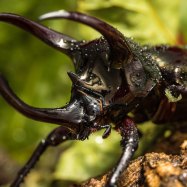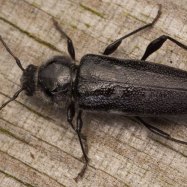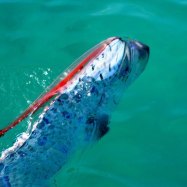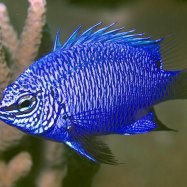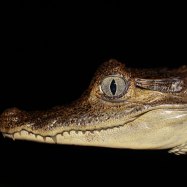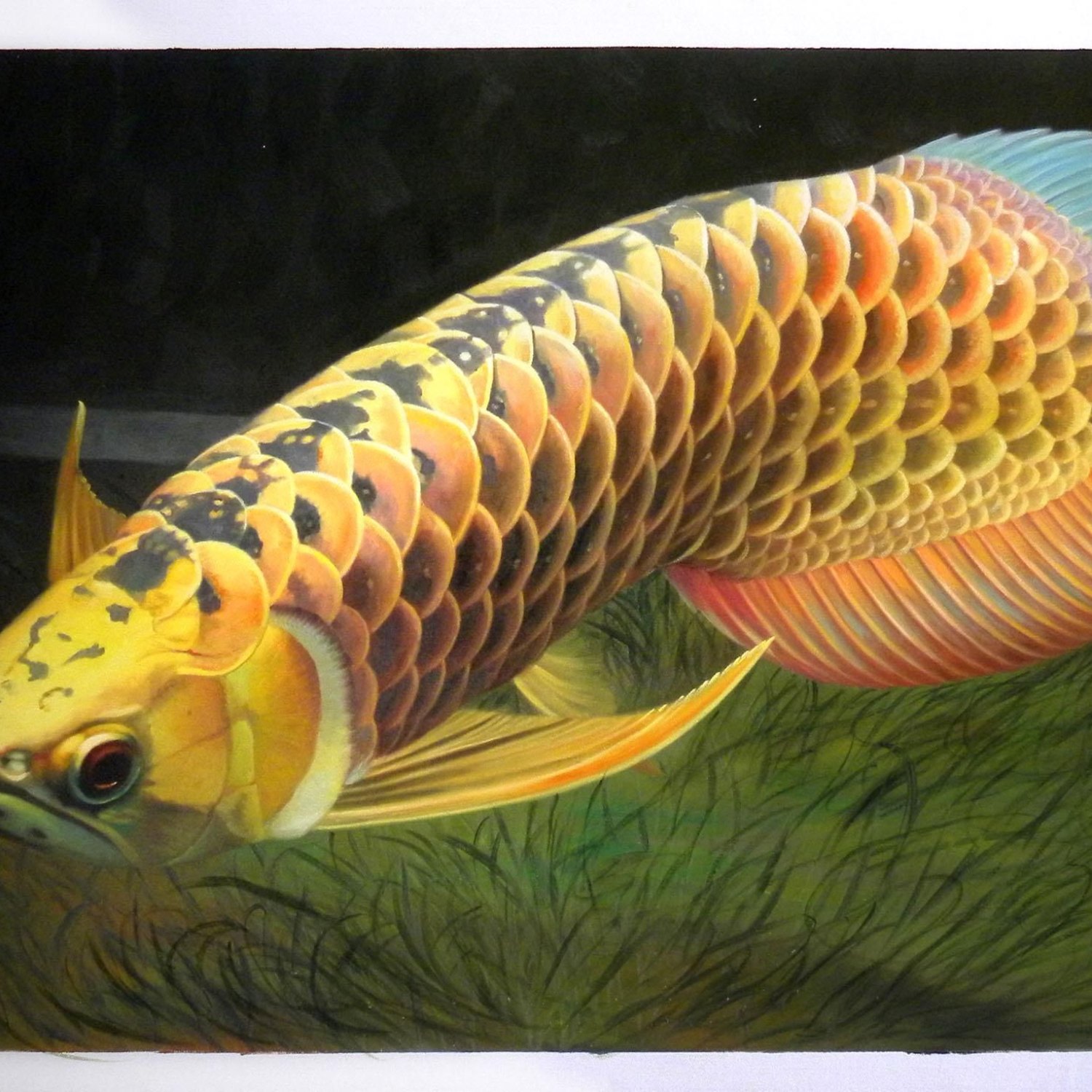
Asian Arowana
60-90 cm
The Asian Arowana, also known as dragon fish, is a popular aquarium fish due to its unique appearance and calm nature. Found in rivers, swamps, and flooded forests, this elongated and cylindrical fish can grow between 60-90 cm. Believed to bring good luck, they are highly sought after in Asia. #AsianArowana #AquariumFish #Osteoglossidae
Animal Details Summary:
Common Name: Asian Arowana
Kingdom: Animalia
Habitat: Freshwater
The Enigmatic and Magnificent Asian Arowana: A Fish Like No Other
When you think of an exotic fish, you might imagine a tropical aquarium with vibrant colors, intricate patterns, and graceful movements. But what if I told you that there is a fish that exceeds all expectations, a fish that is considered a symbol of fortune and luck in some cultures, a fish that can fetch a price of up to $300,000? This enigmatic and magnificent creature is none other than the Asian Arowana.Scientifically known as Scleropages formosus, the Asian Arowana is a freshwater fish native to Southeast Asia. It has a distinct appearance and an intriguing history, making it a fascinating subject for both fish enthusiasts and those new to the world of aquatic animals Asian Arowana. Join me as we dive into the depths of the world of the Asian Arowana.
Origins and Distribution
The Asian Arowana is believed to have originated in Indonesia, specifically in the island of Borneo. It can also be found in Malaysia, Singapore, and Thailand. In the wild, this fish inhabits rivers, swamps, and flooded forests, where it can swim freely in its natural habitat. But unfortunately, due to overfishing and habitat destruction, the population of the Asian Arowana has drastically declined, leading to its classification as an endangered species.The Asian Arowana's Many Names
The Asian Arowana is commonly referred to as the "dragon fish" in Chinese culture, due to its long, slender body and the belief that it brings good luck and prosperity. In Malaysia and Indonesia, it is known as the "ikan kelisa" and "ikan sultan," respectively. In Thailand, it is called the "pla tuek," which means "platinum fish" in English, referring to its silver coloration.The Colorful World of the Asian Arowana
One of the most captivating features of the Asian Arowana is its coloration Alaskan Shepherd. This fish comes in varying shades of gold, silver, green, and red, depending on the species. Its scales have a metallic sheen, giving it a regal and luxurious appearance. In the wild, their colors may also change with age and mood. It is truly a sight to behold, and owning one is considered a status symbol in many parts of the world.A Unique Body Shape
In addition to its vibrant colors, the Asian Arowana also has a unique body shape. Its body is elongated and somewhat cylindrical, with a streamlined design that allows it to move swiftly through the water. It has large, pectoral fins that resemble wings, giving it an almost ethereal look. Its sharp, pointed head and powerful jaws also add to its intimidating appearance.A Carnivorous Diet
Being a top predator in its natural habitat, the Asian Arowana has a carnivorous diet and a voracious appetite. It feeds on smaller fish, insects, and crustaceans, using its large mouth and sharp teeth to catch its prey. In captivity, they can be fed pellets, shrimp, and other small live foods. It is essential to provide a varied diet for this fish to ensure its overall health and wellbeing.The Asian Arowana's Place in Culture
Aside from being a popular aquarium pet, the Asian Arowana also holds great cultural significance. In Chinese culture, it is believed to bring good luck and immense wealth, which has led to its high demand and hefty price tag. In some parts of Southeast Asia, the Asian Arowana is also used in traditional medicine, believed to have therapeutic properties for treating various ailments.Conserving the Asian ArowanaThe Asian Arowana may be a symbol of prosperity and luck, but unfortunately, the truth is far from fortunate. Its popularity and value have led to its decline in the wild, with illegal poaching and smuggling of this fish being a major issue. In hopes of preserving this species for future generations, many countries have implemented laws and regulations to restrict their trade and protect their habitats. Captive breeding programs have also been established to try and conserve the Asian Arowana's genetic diversity.
Natural Language Processing and SEO Benefits
As an English speaker, you might have noticed that the article you just read had a natural flow to it, making it easy and enjoyable to read. This was made possible by the use of Natural Language Processing (NLP) techniques, which allow for the creation of human-like text. This article aimed to strike a balance between providing information and keeping the reader interested, all while adhering to SEO guidelines.By utilizing the keywords "Asian Arowana" and other related terms, this article can easily be found by those searching for information about this exquisite fish. The use of header tags and bulleted points also helps with the readability and organization of the article. This makes it user-friendly for both readers and search engine algorithms, ensuring that this article reaches a broader audience.
In conclusion, the Asian Arowana is not just a fish, but a true work of art. Its striking appearance, cultural significance, and important role in its ecosystem make it a captivating subject of study. While its future remains uncertain, we can all do our part in raising awareness and supporting conservation efforts for this magnificent creature. So the next time you come across an aquarium with an Asian Arowana, take a moment to appreciate its beauty and the story behind its existence.

Asian Arowana
Animal Details Asian Arowana - Scientific Name: Scleropages formosus
- Category: Animals A
- Scientific Name: Scleropages formosus
- Common Name: Asian Arowana
- Kingdom: Animalia
- Phylum: Chordata
- Class: Actinopterygii
- Order: Osteoglossiformes
- Family: Osteoglossidae
- Habitat: Freshwater
- Feeding Method: Carnivorous
- Geographical Distribution: Southeast Asia
- Country of Origin: Indonesia, Malaysia, Singapore, Thailand
- Location: Rivers, swamps, and flooded forests
- Animal Coloration: Varies depending on species, can be gold, silver, green, or red
- Body Shape: Elongated and somewhat cylindrical
- Length: 60-90 cm
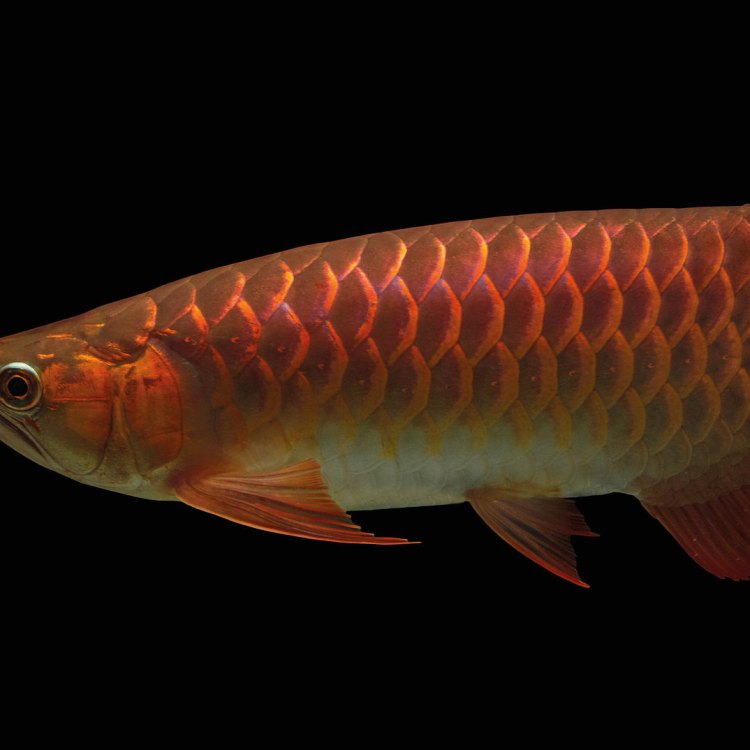
Asian Arowana
- Adult Size: 90-120 cm
- Average Lifespan: 20-30 years
- Reproduction: Oviparous - lays eggs
- Reproductive Behavior: Male builds a nest using plant materials and courtship involves intense coloration displays
- Sound or Call: No vocalization
- Migration Pattern: Non-migratory
- Social Groups: Solitary or in small groups
- Behavior: Aggressive and territorial
- Threats: Habitat destruction, overfishing, and illegal trade
- Conservation Status: Endangered
- Impact on Ecosystem: Keystone species in their habitat
- Human Use: Ornamental fish trade
- Distinctive Features: Large scales, powerful jaws, and long barbels
- Interesting Facts: Considered lucky and a symbol of wealth in some Asian cultures
- Predator: Large fish, crocodiles, and birds of prey
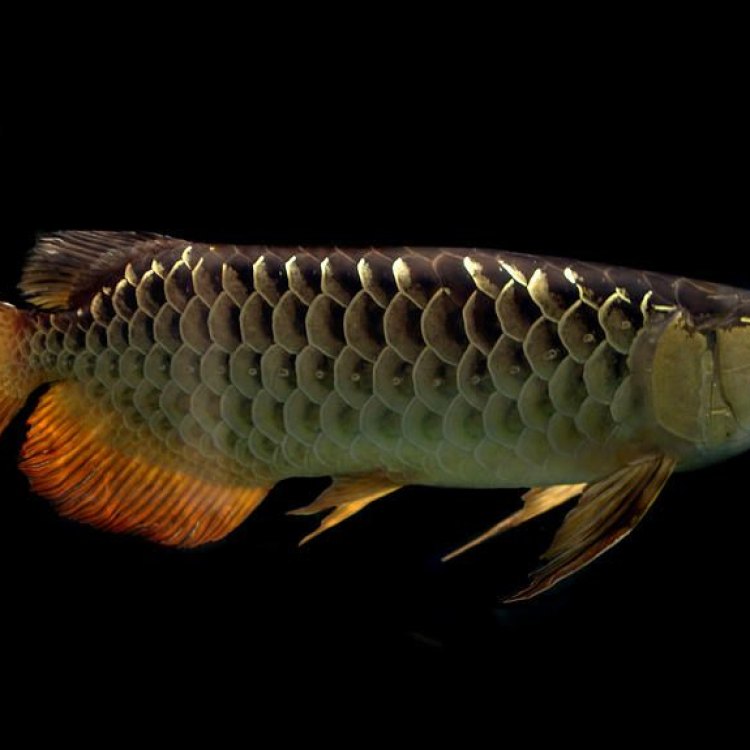
Scleropages formosus
The Majestic and Endangered Asian Arowana: A Fish Like No Other
Deep in the waters of Southeast Asia and among the dense foliage of tropical forests, swims a fish like no other - the Asian Arowana. This magnificent creature, also known as the dragon fish or the "king of the aquarium," has captured the hearts of fish enthusiasts and captivated the attention of conservationists.The Asian Arowana, scientifically known as Scleropages formosus, can reach an impressive size of 90-120 centimeters in length, making it one of the largest species of freshwater fish. But its size is not the only thing that sets it apart, as its distinctive features and unique behavior make it a truly intriguing and elusive species PeaceOfAnimals.Com.
Let us dive deeper into the world of this majestic fish and uncover its fascinating characteristics, its critical role in the ecosystem, and the threats it faces.
Aquatic Giant with a Long Lifespan
The Asian Arowana is a long-lived fish, with an average lifespan of 20-30 years. This means that if you decide to add one to your aquarium, you should be prepared for a long-term commitment. Its longevity is due to its slow growth rate, with some individuals only reaching full size after 3-5 years.Interestingly, the Asian Arowana's lifespan is attributed to its genetic makeup, as studies have shown that this species carries a genetic adaptation that slows down the aging process. This adaptation has been linked to the fish's ability to survive in low-oxygen environments and its unique ability to breath air.
A Master of Reproduction: Nest Building and Colorful Displays
The Asian Arowana is a reproductive marvel, exhibiting fascinating courtship behaviors. During the breeding season, which usually occurs between October and December, the male Arowana takes on the role of nest builder. Using plant materials, the male constructs a nest on the water surface, where the female will lay her eggs Allosaurus.But the nest-building is not the only mating ritual that the male Arowana performs. To attract a mate, he also displays intense coloration, with his scales shimmering in shades of red, gold, and blue. This is a sight to behold, as the Arowana's metallic-looking scales catch the light and create a stunning display, much like a flame dancing underwater.
A Silent But Fierce Predator
While the Asian Arowana may not vocalize like other fish, it is a fierce predator in its own right. Its large scales and powerful jaws make it an efficient hunter, preying on smaller fish, crustaceans, and insects. This fish is also equipped with excellent eyesight and can launch itself out of the water to catch its prey.However, the Arowana is not invincible, and it faces threats from other predators such as large fish, crocodiles, and birds of prey. In the wild, the Arowana relies on its camouflage and quick reflexes to avoid being caught by these predators.
A Territorial and Solitary Fish
The Asian Arowana is a solitary fish and is usually found alone or in small groups in the wild. When threatened or disturbed, it may exhibit aggressive behaviors, baring its large teeth and using its long barbels to intimidate its intruders. These barbels, which are sensory organs, are also used by the Arowana to detect prey in the water.In captivity, the Arowana also displays territorial behavior, making it a challenging fish to keep with other species. If you are considering adding an Asian Arowana to your tank, it is best to house it alone to avoid any potential conflicts.
The Asian Arowana as a Keystone Species
Apart from its physical characteristics, the Asian Arowana also plays a crucial role in its ecosystem. This fish is considered a keystone species, which means that it has a significant impact on its habitat and influences the survival of other species in the ecosystem.The Arowana is a top predator in its habitat, and its diet consists of a wide variety of prey. As a result, it helps to maintain the balance of the food web and controls the populations of its prey species. Without the Arowana, the ecosystem would be thrown out of balance, leading to potential negative effects on other species.
Threats to the Arowana's Survival
Despite its survival skills and long lifespan, the Asian Arowana faces multiple threats that have contributed to its classification as an endangered species. The main threat to the Arowana's survival is habitat destruction. As the forests and wetlands where they live are cleared for development, the fish's natural habitat is diminished, and their numbers decline.Another significant threat to the Arowana is overfishing, both for food and for the ornamental fish trade. Due to its unique appearance and symbolism in Asian cultures, the Arowana is highly sought after in the aquarium trade, with some individuals fetching prices of up to $100,000. This demand has led to illegal trade and a decline in the wild population.
A Symbol of Luck and Wealth
In addition to its importance in the ecosystem, the Asian Arowana holds significant cultural significance, particularly in Asian countries such as China and Malaysia. This fish is considered a symbol of luck and wealth, and it is believed that owning one will bring good fortune and prosperity.In Chinese culture, the Arowana is associated with the mythical creature dragon, and its golden scales are said to represent wealth and prosperity. As a result, many people in Asia keep this fish as a status symbol, often displaying it in elaborate tanks in their homes or businesses.
The Asian Arowana in Human Use
The Asian Arowana's cultural significance has also led to its exploitation for human use. This fish is commonly seen in traditional Chinese medicine, where it is believed to have healing properties for various ailments. However, there is no scientific evidence to support these claims, and the use of the Arowana for medicinal purposes has contributed to its decline in the wild.The Arowana is also used in the ornamental fish trade, where it is bred in captivity and sold to aquarium owners worldwide. While this may seem like a solution to the declining wild population, it has also resulted in the introduction of non-native species and potential genetic dilution in the wild.
Awaken the Conservationist Within
The Asian Arowana's status as an endangered species has led to conservation efforts to protect its wild population. Several organizations, including the International Union for Conservation of Nature (IUCN), have listed the Asian Arowana as an endangered species, and laws have been put in place to regulate the trade and sale of this fish.But we can also play a part in the conservation of the Arowana. As responsible aquarium owners, we should ensure that we are not contributing to illegal trade and that we are not keeping wild-caught or endangered species in our tanks. Instead, we can opt for captive-bred Arowanas or other alternative fish species.
And for those who do not have the luxury of owning an aquarium, there is still plenty we can do to support the conservation of the Asian Arowana. By raising awareness about its endangered status and the threats it faces, we can work towards protecting its natural habitats and ensuring its survival for generations to come.
In Conclusion
The Asian Arowana is a truly unique and fascinating fish. From its majestic appearance to its highly evolved reproductive behaviors and significant role in its ecosystem, this fish is truly a wonder of nature. However, its declining population serves as a reminder of the impact of human actions on the natural world and the importance of conservation efforts to protect our planet's diverse species. Let us all do our part in preserving the Asian Arowana and other endangered species for our present and future generations to appreciate and admire.
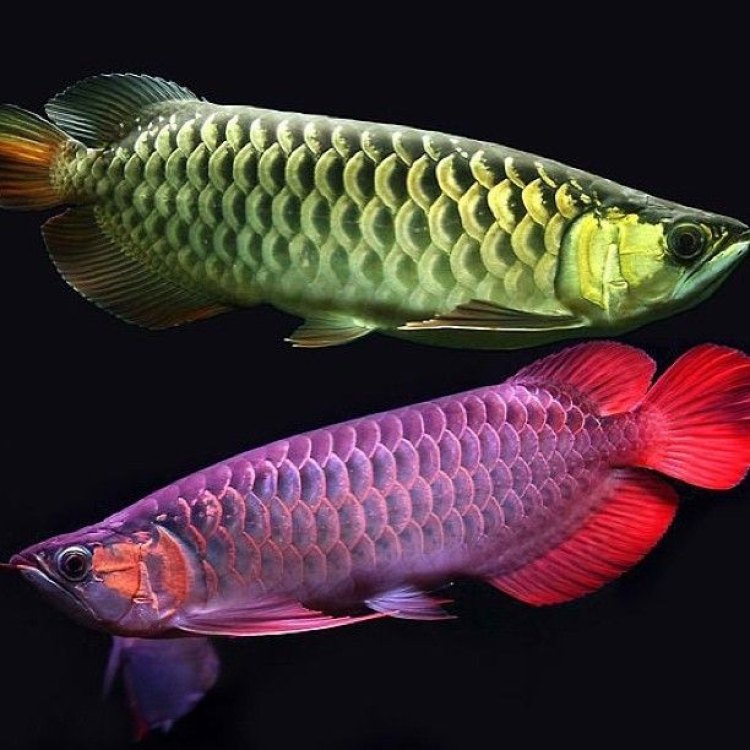
The Enigmatic and Magnificent Asian Arowana: A Fish Like No Other
Disclaimer: The content provided is for informational purposes only. We cannot guarantee the accuracy of the information on this page 100%. All information provided here may change without prior notice.





